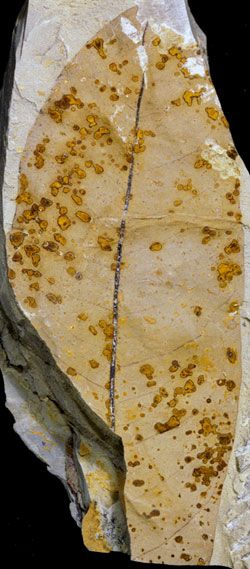Insect Invasion Possible as Climate Warms

Global warming could bring about a veritable insect explosion, if past performance is an indication of future gains.
Just such a buggy invasion swarmed parts of the northern United States during an abrupt global warming event more than 50 million years ago, a new study of leaf fossils shows.
The study's findings, detailed in the Feb. 11 issue of the journal Proceedings of the National Academy of Sciences, indicate that the same thing could happen during our current period of warming.
Holes, mines and galls
The most diverse range of insects today can be found in the tropics, along with the most insect damage to leaves. These observations indicate a correlation between warmer temperatures and insect diversity.
Insect diversity in an area can be inferred from the amount and types of damage found on the leaves of local plant life. The scars left on leaves from munching insects can even be seen in fossils.
Different types of insects leave different types of marks from their meal. Some, such as beetles, simply chew holes in the leaves. Some butterflies leave marks called "mines" that result when the insect's egg hatches and the larva eats a "feeding channel" through the leaf, says study leader Ellen Currano, a graduate student at Penn State.
Sign up for the Live Science daily newsletter now
Get the world’s most fascinating discoveries delivered straight to your inbox.
Another mark left by insect larvae that hatch in the leaf, called "galls," are like "balls of thickened tissue" that the larva eats, as Currano describes it.
The researchers looked for evidence of these scars in more than 5,000 leaf fossils from the Bighorn Basin in Wyoming. The leaf fossils date from before, during and after the Paleocene-Eocene Thermal Maximum (PETM), an abrupt global warming event comparable to our current state of climate change that occurred about 56 million years ago. The changes in the amount and types of marks left by leaf-munching insects, as well as the percentage of devoured leaves, indicated how many of the creepy crawlies were in the area under different climatic conditions.
Hungry, hungry insects
Currano and her colleagues found that during the comparatively cooler end of the Paleocene epoch, 15 to 38 percent of leaves showed insect damage. Similarly, later on at the beginning of the Eocene, when temperatures had dropped after the thermal maximum, 33 percent of leaves were damaged. But during the warmth of the PETM, insect damage was found on 57 percent of leaves.
"We … see this big jump in the percentage of leaves that have any kind of damage," Currano said.
Currano and her colleagues think these more voracious insect appetites were a result of a concurrent rise in carbon dioxide levels during the PETM that would have made plant leaves less nutritious.
"With more carbon dioxide available to plants, photosynthesis is easier and plants can make the same amount of food for themselves without having to put so much protein in their leaves," so insects have to eat more of a leaf to get the same amount of nutrition they did before, Currano explained.
The same feeding frenzy could occur as carbon dioxide levels continue to rise today, as several studies have shown that some plants produce fewer nutrients in elevated carbon dioxide levels.
Along with hungrier insects could come a change in the type of plants and bugs in northerly regions.
The plants in the three different time periods the team studied were all different and showed an increase in biodiversity in the PETM that suggests to the researchers that plant species slowly migrated from the Gulf Coast area as temperatures warmed. Currano says that insects could have followed the same route.
"They're also following the plants that they ate on further south," she told LiveScience.
Because the PETM is comparable in the size and rate of warming to the current climate change regime, Currano and her team think it likely that such an invasion of hungry insects could eventually occur in modern times.
- Top 10 Surprising Results of Global Warming
- Backyard Bugs: The Best of Your Images
- Quiz: Global Weather Extremes

Andrea Thompson is an associate editor at Scientific American, where she covers sustainability, energy and the environment. Prior to that, she was a senior writer covering climate science at Climate Central and a reporter and editor at Live Science, where she primarily covered Earth science and the environment. She holds a graduate degree in science health and environmental reporting from New York University, as well as a bachelor of science and and masters of science in atmospheric chemistry from the Georgia Institute of Technology.